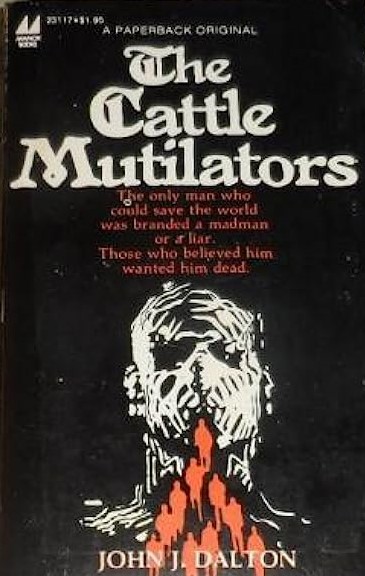 By JOHN J. DALTON (Manor Books; 1980)
By JOHN J. DALTON (Manor Books; 1980)
Unexplained cattle mutilations were and remain a subject of boundless fascination. Said mutilations, which tend to involve surgically precise, bloodless incisions of and around the vital organs of cows and other animals, can be traced back to 17th Century England (and stretch forward to the present day), but appear to have been most widely documented in the mid and southwestern United States during the 1960s and 70s. New Mexico, it seems, was especially hard hit, which explains why no less than two cattle mutilation themed novels, THE MUTE STRATEGY by Dave DeWitt and THE CATTLE MUTILATORS by John J. Dalton (published within a year of each other), were set therein (another take on the subject occurred in the 1982 film ENDANGERED SPECIES, which took place in Wyoming).
The most popular suppositions for the mutilations tend to involve government conspiracies and aliens, and in THE CATTLE MUTILATORS John J. Dalton utilizes both. The protagonist is Jerry Brandon, a surgeon in an Albuquerque hospital who’s drawn into the mutilation mystery when several humans turn up bearing incisions similar to those of the afflicted cattle, among them a hippie couple who survive the ordeal and report seeing an impossibly bright bright light in the sky.
I don’t think I need to inform you that the explanation for this insanity involves extraterrestrial intelligence, and that said extraterrestrials have designs on us that are quite perverse (as in a passage in which a woman is abducted by an alien who renders her multi-orgasmic). Brandon somehow becomes the lynchpin of the aliens’ plans, and lands in an insane asylum because of that, with the government fully aware of what’s happening and eager to cover it up.
This being a paperback horror novel from 1980, you really can’t expect too much from it. The narrative isn’t particularly well thought out (how is it that only Brandon is able to figure out the true nature of the mutilators?), and nor is it very original (with the aliens ultimately assuming paternalistic DAY THE EARTH STOOD STILL roles, demanding we earthlings change our warmongering ways or else). The prose isn’t anyone’s idea of eloquent, with certain pivotal events (such as Brandon’s incarceration) related in the form of after-the-fact recollections by ancillary characters, and evidences telltale signs of hasty writing (such as the fact that, confusingly, the protagonist is referred to by the author as both Jerry and Brandon).
The author’s research into the medial profession feels authentic, with Brandon having to contend not only with alien intrusions but also with the bitterness and jealousy of his colleagues. Plus, the story, perfunctory though it is, is engagingly nutty enough to keep the pages turning.
